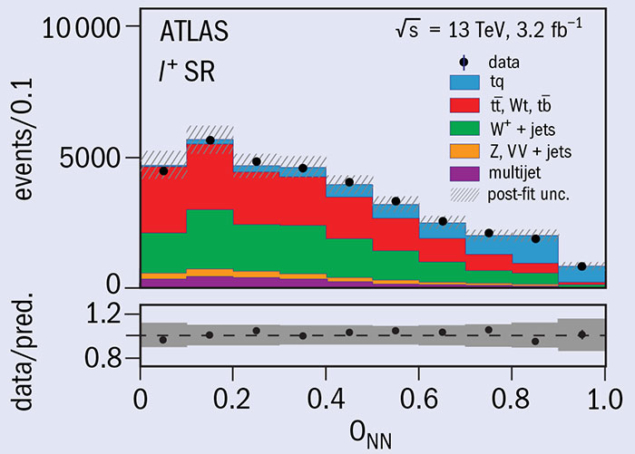
The ATLAS collaboration is exploiting the window of opportunity opened by the LHC’s 13 TeV run to search directly for unknown particles. Complementary to this approach, the collaboration is also looking for deviations in the cross-sections and kinematic distributions of Standard Model processes, which could be caused by energy-dependent couplings that become accessible at the higher collision energy.
Using data recorded in 2015 corresponding to an integrated luminosity of 3.2 fb–1, ATLAS has recently measured the total cross-sections of single top-quark and top-antiquark production via the t-channel exchange of virtual W bosons. This channel has exciting kinematic features such as polarised top-quarks and forward spectator jets. Compared to the dominant top-quark−top-antiquark (tt) pair-production process, however, the single-production process is experimentally more challenging due to a higher background level. Because the two major background processes are W+jets and tt pair production, the selection of candidate events requires one charged lepton, missing transverse momentum and two hadronic jets to be present (exactly one of which has to be identified to contain b hadrons).
To measure the cross-section of top-quark and top-antiquark production separately, the events are separated into two channels according to the sign of the lepton charge. ATLAS uses neural networks to exploit the kinematic differences between the signal and background processes as much as possible, thereby optimising the statistical power of the data set. Ten different kinematic variables were combined into a discriminant, which is assumed to be close to zero for background-like events and unity for signal-like events (see figure).
The cross-sections were measured to be 156±28 pb for top-quark production and 91±19 pb for top-antiquark production. These are slightly higher than expected (+15% and +12%, respectively), but still in good agreement with the predictions. The largest uncertainties are related to the Monte Carlo generators used to model the t-channel single top-quark process and the tt pair-production process, the b-jet identification efficiency and the jet energy scale. In future measurements of the single top-quark process, the focus will be on reducing the uncertainties, exploiting improved calibrations and extending studies of the Monte Carlo generators.





